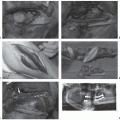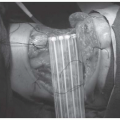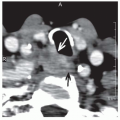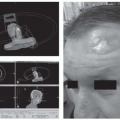Surgical Pathology Cancer Case Summary (Checklist) |
Protocol web posting date: June 2012 |
Pharynx (Oropharynx, Hypopharynx, Nasopharynx): Incisional Biopsy, Excisional Biopsy, Resection |
Select a single response unless otherwise indicated. |
Specimen (select all that apply) |
___ Oropharynx |
___ Nasopharynx |
___ Hypopharynx |
___ Other (specify): ____________________ |
___ Not specified |
Received |
___ Fresh |
___ In formalin |
___ Other (specify): ____________________ |
Procedure (select all that apply) |
___ Incisional biopsy |
___ Excisional biopsy |
___ Resection |
|
___ Tonsillectomy |
|
___ Laryngopharyngectomy |
|
___ Other (specify): ____________________ |
___ Neck (lymph node) dissection (specify): ____________________ |
___ Other (specify): ____________________ |
___ Not specified |
* Specimen Integrity |
*___ Intact |
*___ Fragmented |
Specimen Size |
Greatest dimensions: ___ × ___ × ___ cm |
* Additional dimensions (if more than one part): ___ × ___ × ___ cm |
Specimen Laterality (select all that apply) |
___ Left |
___ Right |
___ Bilateral |
___ Midline |
___ Not specified |
Tumor Site (select all that apply) |
___ Oropharynx |
|
___ Palatine tonsil |
|
___ Base of tongue, including lingual tonsil |
|
___ Soft palate |
|
___ Uvula |
|
___ Pharyngeal wall (posterior) |
|
___ Other |
___ Nasopharynx |
|
___ Nasopharyngeal tonsils (adenoids) |
___ Hypopharynx |
|
___ Piriform sinus |
|
___ Postcricoid |
|
___ Pharyngeal wall (posterior and/or lateral) |
|
___ Other |
___ Other (specify): ____________________ |
___ Not specified |
Tumor Laterality (select all that apply) |
___ Left |
___ Right |
___ Bilateral |
___ Midline |
___ Not specified |
Tumor Focality |
___ Single focus |
___ Bilateral |
___ Multifocal (specify): _______________ |
Tumor Size |
Greatest dimension: ___ cm |
* Additional dimensions: ___ × ___ cm |
___ Cannot be determined (see Comment) |
* Tumor Description (select all that apply) |
* Gross subtype: |
*___ Polypoid |
*___ Exophytic |
*___ Endophytic |
*___ Ulcerated |
*___ Sessile |
*___ Other (specify): ____________________ |
* Macroscopic Extent of Tumor |
* Specify: _______________ |
Histologic Type (select all that apply) |
Carcinomas of the Oropharynx and Hypopharynx |
___ Squamous cell carcinoma, conventional |
Variants of Squamous Cell Carcinoma |
___ Acantholytic squamous cell carcinoma |
___ Adenosquamous carcinoma |
___ Basaloid squamous cell carcinoma |
___ Papillary squamous cell carcinoma |
___ Spindle cell squamous carcinoma |
___ Verrucous carcinoma |
___ Lymphoepithelial carcinoma (nonnasopharyngeal) |
Carcinomas of the Nasopharynx |
___ Keratinizing squamous cell carcinoma (formerly WHO-1) |
___ Nonkeratinizing carcinoma |
|
___ Differentiated carcinoma (formerly WHO-2; transitional carcinoma) |
|
___ Undifferentiated carcinoma (formerly WHO-3; lymphoepithelioma) |
___ Basaloid squamous cell carcinoma |
Adenocarcinomas (Non-Salivary Gland Type) |
___ Nasopharyngeal papillary adenocarcinoma |
___ Adenocarcinoma, not otherwise specified (NOS) |
|
___ Low grade |
|
___ Intermediate grade |
|
___ High grade |
___ Other (specify): ____________________ |
Carcinomas of Minor Salivary Glands |
___ Acinic cell carcinoma |
___ Adenoid cystic carcinoma |
___ Adenocarcinoma, not otherwise specified (NOS) |
___ Low grade |
___ Intermediate grade |
___ High grade |
___ Basal cell adenocarcinoma |
___ Carcinoma ex pleomorphic adenoma (malignant mixed tumor) |
___ Carcinoma, type cannot be determined |
___ Clear cell adenocarcinoma |
___ Cystadenocarcinoma |
___ Epithelial-myoepithelial carcinoma |
___ Mucoepidermoid carcinoma |
|
___ Low grade |
|
___ Intermediate grade |
|
___ High grade |
___ Mucinous adenocarcinoma (colloid carcinoma) |
___ Myoepithelial carcinoma (malignant myoepithelioma) |
___ Oncocytic carcinoma |
___ Polymorphous low-grade adenocarcinoma |
___ Salivary duct carcinoma |
___ Other (specify): ____________________ |
Neuroendocrine Carcinoma |
___ Typical carcinoid tumor (well-differentiated neuroendocrine carcinoma) |
___ Atypical carcinoid tumor (moderately differentiated neuroendocrine carcinoma) |
___ Small cell carcinoma (poorly differentiated neuroendocrine carcinoma) |
___ Combined (or composite) small cell carcinoma, neuroendocrine type |
___ Mucosal malignant melanoma |
___ Other carcinoma (specify): ____________________ |
___ Carcinoma, type cannot be determined |
Histologic Grade |
___ Not applicable |
___ GX: Cannot be assessed |
___ G1: Well differentiated |
___ G2: Moderately differentiated |
___ G3: Poorly differentiated |
___ Other (specify): ____________________ |
* Microscopic Tumor Extension |
*___ Specify: ____________________ |
Margins (select all that apply) |
___ Cannot be assessed |
___ Margins uninvolved by invasive carcinoma |
|
Distance from closest margin: ___ mm or ___ cm |
|
|
Specify margin(s), per orientation, if possible: __________ |
___ Margins involved by invasive carcinoma |
|
Specify margin(s), per orientation, if possible: __________ |
___ Margins uninvolved by carcinoma in situ (includes moderate and severe dysplasia#) (Note D) |
|
Distance from closest margin: ___ mm or ___ cm |
|
|
Specify margin(s), per orientation, if possible: __________ |
___ Margins involved by carcinoma in situ (includes moderate and severe dysplasia#) (Note D) |
|
Specify margin(s), per orientation, if possible: __________ |
___ Not applicable |
#Applicable only to squamous cell carcinoma and histologic variants |
* Treatment Effect (applicable to carcinomas treated with neoadjuvant therapy) |
*___ Not identified |
*___ Present (specify): _______________ |
*___ Indeterminate |
Lymph-Vascular Invasion |
___ Not identified |
___ Present |
___ Indeterminate |
Perineural Invasion |
___ Not identified |
___ Present |
___ Indeterminate |
Lymph Nodes, Extranodal Extension |
___ Not identified |
___ Present |
___ Indeterminate |
Pathologic Staging (pTNM) |
Note: The phrases in italics include clinical findings required for AJCC staging. This clinical information may not be available to the pathologist. However, if known, these findings should be incorporated into the pathologic staging. |
TNM Descriptors (required only if applicable) (select all that apply) |
___ m (multiple primary tumors) |
___ r (recurrent) |
___ y (posttreatment) |
Primary Tumor (pT) |
___ pTX: Cannot be assessed |
___ pT0: No evidence of primary tumor |
___ pTis: Carcinoma in situ |
For All Carcinomas Excluding Mucosal Malignant Melanoma |
Primary Tumor (pT): Oropharynx |
___ pT1: Tumor 2 cm or less in greatest dimension |
___ pT2: Tumor more than 2 cm but not more than 4 cm in greatest dimension without fixation ofhemilarynx |
___ pT3: Tumor more than 4 cm in greatest dimension or with fixation of hemilarynx or extension to lingual surface of epiglottis |
___ pT4a: Moderately advanced local disease. Tumor invades larynx, deep/extrinsic muscle of tongue, medial pterygoid muscles, hard palate, or mandible# |
___ pT4b: Very advanced local disease. Tumor invades lateral pterygoid muscle, pterygoid plates, lateral nasopharynx, or skull base, or encases carotid artery |
#Note: Mucosal extension to lingual surface of epiglottis from primary tumors of the base of the tongue and vallecula does not constitute invasion of larynx. |
Primary Tumor (pT): Nasopharynx |
___ pT1: Tumor confined to nasopharynx, or tumor extends to oropharynx and/or nasal cavity without parapharyngeal extension# |
___ pT2: Tumor with parapharyngeal extension# |
___ pT3: Tumor invades bony structures of skull base and/or paranasal sinuses |
___ pT4: Tumor with intracranial extension and/or involvement of cranial nerves, hypopharynx, orbit, or with extension to the infratemporal fossa/masticator space |
#Parapharyngeal extension denotes posterolateral infiltration of tumor. |
Primary Tumor (pT): Hypopharynx |
___ pT1: Tumor limited to one subsite of hypopharynx and/or 2 cm or less in greatest dimension |
___ pT2: Tumor invades more than one subsite of hypopharynx or an adjacent site, or measures more than 2 cm but not more than 4 cm in greatest dimension without fixation of hemilarynx |
___ pT3: Tumor measures more than 4 cm in greatest dimension orwith fixation of hemilarynx or extension to esophagus |
___ pT4a: Moderately advanced local disease. Tumor invades thyroid/cricoid cartilage, hyoid bone, thyroid gland, or central compartment soft tissue# |
___ pT4b: Very advanced local disease. Tumor invades prevertebral fascia, encases carotid artery, or involves mediastinal structures |
#Note: Central compartment soft tissue includes prelarnygeal strap muscles and subcutaneous fat. |
Regional Lymph Nodes (pN) |
___ pNX: Cannot be assessed |
___ pN0: No regional lymph node metastasis |
Regional Lymph Nodes (pN): Oropharynx and Hypopharynx# |
___ pN1: Metastasis in a single ipsilateral lymph node, 3 cm or less in greatest dimension |
___ pN2: Metastasis in a single ipsilateral lymph node, more than 3 cm but not more than 6 cm in greatest dimension, or in multiple ipsilateral lymph nodes, none more than 6 cm in greatest dimension, or in bilateral or contralateral lymph nodes, none more than 6 cm in greatest dimension |
___ pN2a: Metastasis in a single ipsilateral lymph node, more than 3 cm but not more than 6 cm in greatest dimension |
___ pN2b: Metastasis in multiple ipsilateral lymph nodes, none more than 6 cm in greatest dimension |
___ pN2c: Metastasis in bilateral or contralateral lymph nodes, none more than 6 cm in greatest dimension |
___ pN3: Metastasis in a lymph node more than 6 cm in greatest dimension |
___ No nodes submitted or found |
Number of Lymph Nodes Examined |
Specify: _____ |
___ Number cannot be determined (explain): _______________ |
Number of Lymph Nodes Involved |
Specify: ___ |
___ Number cannot be determined (explain): _______________ |
|
* Size (greatest dimension) of the largest positive lymph node: ___ |
#Note: Metastases at level VII are considered regional lymph node metastases. Midline nodes are considered ipsilateral nodes. |
Regional Lymph Nodes (pN): Nasopharynx# |
___ pN1: Unilateral metastasis in lymph node(s), 6 cm or less in greatest dimension, above the supraclavicular fossa## |
___ pN2: Bilateral metastasis in lymph node(s), 6 cm or less in greatest dimension, above the supraclavicular fossa## |
___ pN3: Metastasis in a lymph node greater than 6 cm and/or to supraclavicular fossa## |
___ pN3a: Greater than 6 cm in dimension |
___ pN3b: Extension to the supraclavicular fossa## |
___ No nodes submitted or found |
Number of Lymph Nodes Examined |
Specify: _____ |
___ Number cannot be determined (explain): _______________ |
Number of Lymph Nodes Involved |
Specify: _____ |
___ Number cannot be determined (explain): _______________ |
|
* Size (greatest dimension) of the largest positive lymph node: _____ |
#Metastases at level VII are considered regional lymph node metastases. Midline nodes are considered ipsilateral nodes. |
##Supraclavicular zone or fossa is relevant to the staging of nasopharyngeal carcinoma and is the triangular region defined by three points: (1) the superior margin of the sternal end of the clavicle, (2) the superior margin of the lateral end of the clavicle, (3) the point where the neck meets the shoulder (see Figure 1-3, no. 2). Note that this would include caudal portions of Levels IV and VB. All cases with lymph nodes (whole or part) in the fossa are considered N3b. |
Distant Metastasis (pM) |
___ Not applicable |
___ pM1: Distant metastasis |
|
* Specify site(s), if known: ____________________ |
* Source of pathologic metastatic specimen (specify): __________ |
For Mucosal Malignant Melanoma |
Primary Tumor (pT) |
___ pT3: Mucosal disease |
___ pT4a: Moderately advanced disease. Tumor involving deep soft tissue, cartilage, bone, or overlying skin. |
___ pT4b: Very advanced disease. Tumor involving brain, dura, skull base, lower cranial nerves (IX, X, XI, XII), masticator space, carotid artery, prevertebral space, or mediastinal structures. |
Regional Lymph Nodes (pN) |
___ pNX: Regional lymph nodes cannot be assessed |
___ pN0: No regional lymph node metastases |
___ pN1: Regional lymph node metastases present |
Distant Metastasis (pM) |
___ Not applicable |
___ pM1: Distant metastasis present |
|
* Specify site(s), if known: ____________________ |
|
* Source of pathologic metastatic specimen (specify): __________ |
* Additional Pathologic Findings (select all that apply) |
*___ None identified |
*___ Keratinizing dysplasia |
|
*___ Mild |
|
*___ Moderate |
|
*___ Severe (carcinoma in situ) |
*___ Nonkeratinizing dysplasia |
|
*___ Mild |
|
*___ Moderate |
|
*___ Severe (carcinoma in situ) |
*___ Inflammation (specify type): ____________________ |
*___ Squamous metaplasia |
*___ Epithelial hyperplasia |
*___ Colonization |
|
*___ Fungal |
|
*___ Bacterial |
*___ Other (specify): ____________________ |
Ancillary Studies (required only for oropharynx [p16, HPV] and nasopharynx [EBV] if available at time of report completion) (select all that apply) (Notes M and 0) |
___ p16 |
|
___ Positive |
|
___ Negative |
___ Human papillomavirus (HPV), in situ hybridization (ISH) |
|
Type (specify): ____________________ |
|
___ Positive |
|
|
Pattern |
|
|
___ Punctate |
|
|
___ Diffuse |
|
|
___ Mixed |
|
___ Negative |
|
___ Indeterminate (explain): _______________ |
___ HPV, polymerase chain reaction (PCR) |
|
Type (specify): _______________ |
|
___ Positive |
|
___ Negative |
___ Epstein-Barr virus (Epstein-Barr virus-encoded RNA [EBER], other) |
|
___ Positive |
|
___ Negative |
___ Other (specify): ____________________ |
___ Not specified |
* Clinical History (select all that apply) |
*___ Neoadjuvant therapy |
|
*___ Yes (specify type): ____________________ |
|
*___ No |
|
*___ Indeterminate |
*___ Other (specify): ____________________ |
* Data elements preceded by this symbol are not required. However, these elements may be clinically important but are not yet validated or regularly used in patient management. |









